Home Donate New Search Gallery Reviews How-To Books Links Workshops About Contact
The
Importance of Timing
© 2006-2012 KenRockwell.com
My biggest source of support is when you use any of these links when you get anything, regardless of the country in which you live. Thank you! Ken.
INTRODUCTION
I've been telling everyone for years how important timing is to color. Here are some examples.
These are straight out of my D200 and 18 - 200 VR, except for resizing and branding. There's been no color or exposure tweaking. I have full-sized example files from this camera combo here.
The published sunset was 7:05 PM. That's the time at which the sun drops below the water if you're at the beach. Of course it goes away sooner if there's a mountain or building in the way. The best sky colors for these sorts of shots usually happen a half hour afterwards. This varies depending on weather, God, latitude, time of year and elevation, so I can't cheat and simply shoot 30 minutes after sunset.
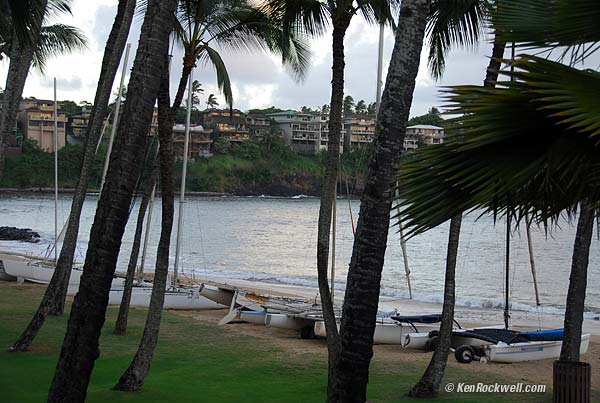
6:48 PM. 46 minutes too early. Sky is mostly gray and overpowers artificial light. Looks the same up to 7:24 PM, just 10 minutes before optimum.
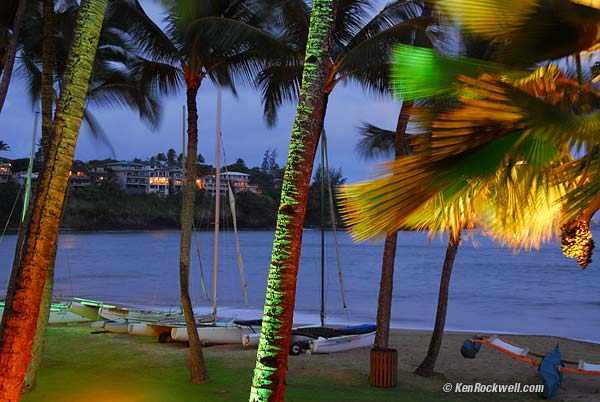
7:28 PM, 6 minutes too early. Nice, but the sky is too light and too gray.
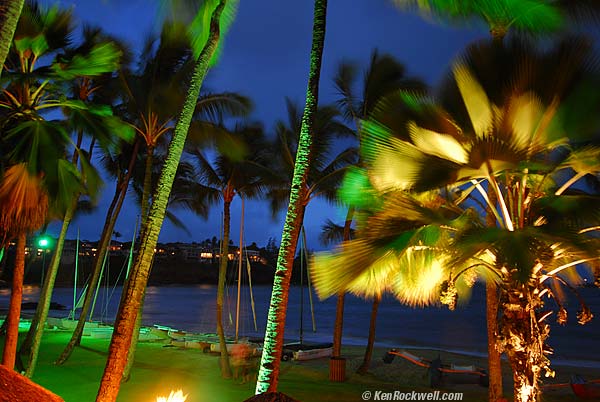
7:34 PM, perfect. I deliberately waited until the sky's blue balanced with the artificial light on the trees.
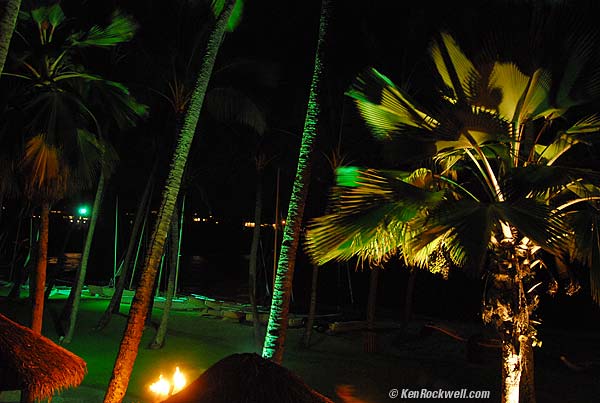
8:13 PM, 39 minutes too late. The sky is black. It's too dark so there's no detail in most of the image.
DISCUSSION
I made these shots having dinner with my family at Duke's Canoe Club in Kauai, Hawaii. I always have my camera and pointed it off the balcony. No tripod, no big deal. Just ignoring the family and trying not to get caught. The location doesn't matter. Timing and lighting is what makes this shot.
It's tough to shoot and be social. Normal people have dinner during the best times for photography.
I started making the "perfect" shot while everyone was starting to look at the menu and order. I only had a few minutes of the best light.
The sky turns from blue to black if you're late. Boring. All parts of the image which should be lit from the dim blue sky become dark, void and without form. God could say "Let there be light," but I lack that omnipotence and shoot before it goes black. People are amazed at how I get such detail in my night shots. Duh, shoot earlier.
As always, my D200 was left on its defaults of Matrix metering and Program auto exposure. The latest shots got the most exposure and are still darkest.
The ideal shot is when the artificial light on the trees and the light in the fading sky match. This lasts for only a few minutes. Since we were eating I didn't have the nerve to make examples at each minute, which would have shown the importance of shooting at just the right minute. Don't let these examples let you think I had a 40 minute window to get the best shot. I had more like a two minute window.
I realized I needed to write an article on this, so I went back the next day and made the early shot, before we had dinner again. I paid attention while we ate (and didn't make photographs), and realized that the light remained the same up until just 10 minutes before the time of the ideal shot! Dull turned into explosive across just 10 minutes.
My family didn't realize how wild the colors looked while I photographed. I showed them on my screen and they were amazed.
Evening colors look more vivid in a photograph because our eyes are less sensitive to color in dim light. Do you think the world really turns gray at night? No, it just looks that way to our eyes. Cameras retain the same color sensitivity as they do in daylight. Cameras are more sensitive to color than our eyes in dim light. Therefore photos made during dusk and at night look more vivid than we see the original scene.
ANOTHER EXAMPLE FROM KAUAI, HAWAII
Here's another sequence. I wasn't intending this as an example, but it became one.
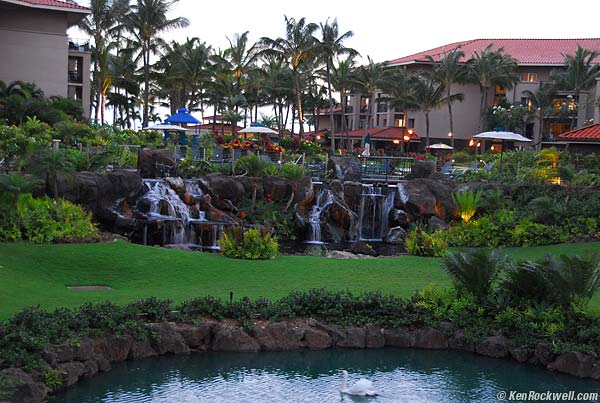
7:14 PM. Too early and too blue. Crooked, too. The lights are on, but overpowered by the ambient light.
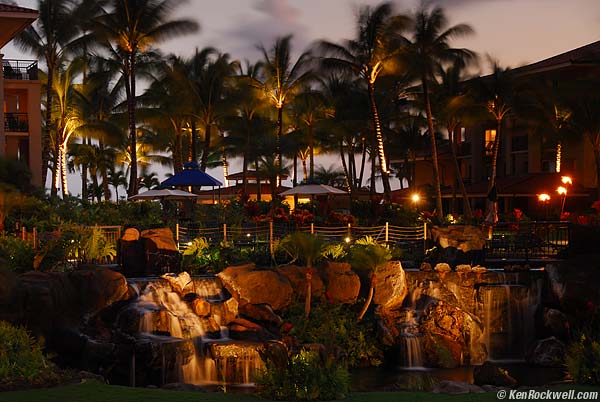
7:30 PM. Lights are starting to balance, but the sky is still too light and gray. These shots look good at the time, but you can't give up because the light's still getting better as the sky gets darker and bluer.
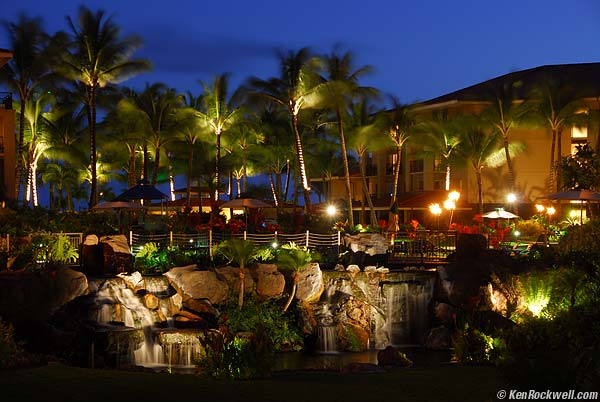
7:44 PM. Perfect!
These shots were easy. All I had to do was match the ambient light in the sky to the artificial light on the trees. It's much tougher catching the right moment when the last vestiges of orange daylight wash across a landscape. The toughest natural event to catch is the green flash, which lasts less than a second.
I catch this with experience gained from shooting a lot of extra shots before and after what I thought was the magic moment. The more you shoot, the more you'll be able to recognize when the magic happens as it happens. Until then, shoot plenty and pick the best later. You're lucky: I had to learn all this on film!
Long-Term Timing
The above is the good news.
The bad news is that light changes by season, and different seasons look different.
You may have to wait years to get some shots.
Extreme weather conditions can lead to spectacular images, and these conditions may only happen once in a lifetime. Some of my favorite shots happened only because Mt. Pinatubo exploded in the Philippines, filled the earth's air with high-altitude dust, and turned the skies once-in-a-lifetime colors.
Many great shots are made only after years of observing a subject, learning when it looks best, and returning to photograph it at its most spectacular. This is how real photographers make anything look extraordinary.
Good luck!
See also How I Get These Colors.
Help me help you top
I support my growing family through this website, as crazy as it might seem.
The biggest help is when you use any of these links when you get anything, regardless of the country in which you live. It costs you nothing, and is this site's, and thus my family's, biggest source of support. These places have the best prices and service, which is why I've used them since before this website existed. I recommend them all personally.
If you find this page as helpful as a book you might have had to buy or a workshop you may have had to take, feel free to help me continue helping everyone.
If you've gotten your gear through one of my links or helped otherwise, you're family. It's great people like you who allow me to keep adding to this site full-time. Thanks!
If you haven't helped yet, please do, and consider helping me with a gift of $5.00.
As this page is copyrighted and formally registered, it is unlawful to make copies, especially in the form of printouts for personal use. If you wish to make a printout for personal use, you are granted one-time permission only if you PayPal me $5.00 per printout or part thereof. Thank you!
Thanks for reading!
Mr. & Mrs. Ken Rockwell, Ryan and Katie.
Home Donate New Search Gallery Reviews How-To Books Links Workshops About Contact
